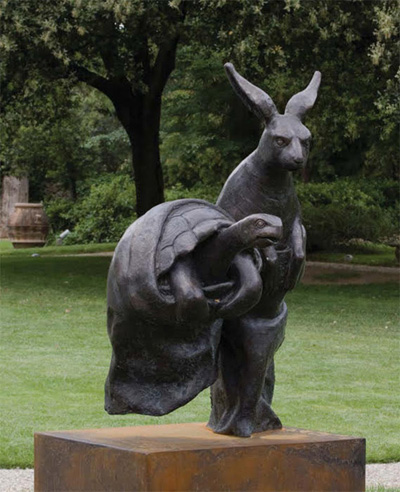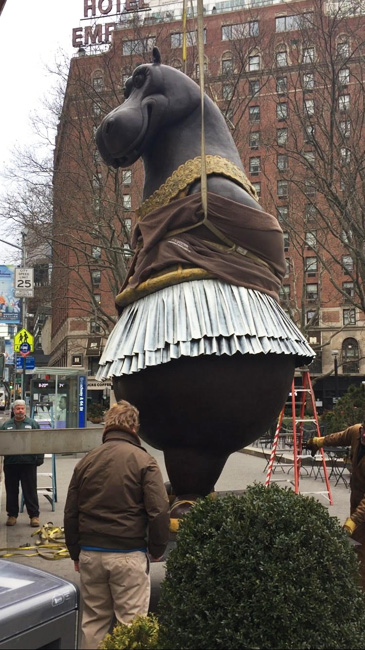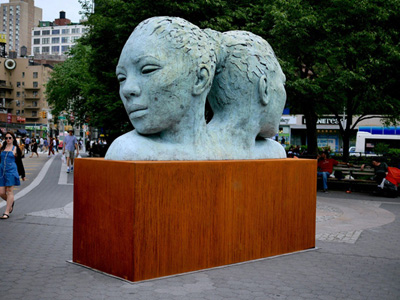NYC Art in the Parks Brings Emerging Bronze Sculptors to the Public Eye
A cheetah riding a scooter, a hare and a tortoise engaged in a potato sack race and a gigantic hippo ballenira are among the whimsical and playful bronze sculptures that evoke a sense of humor by Bjorn Skaarup. His work defies the more serious tone typically associated with this traditional material and his work has been a lively addition to the NYC Art in the Parks program.
Lindsay Ebanks, the Director of Cavalier Gallery discussed what makes them so appealing.
“What we love about the work is its sense of humor—it is a wonderful work of art, but not taking it too seriously,” Ebanks says.
 Hare and the Tortoise by Bjorn Skaarup.
Hare and the Tortoise by Bjorn Skaarup.Photo courtesy of Bjorn Skaarup.
Their scale is in stark comparison to Skaarup’s fifteen foot tall Hippo Ballerina sculpture, also in bronze, that is currently on display at Dante Park at Lincoln Center through the NYC Art in the Parks Program. However, if you fancy hippos, small-scale limited edition castings will be available for collectors at the companion exhibition at Cavalier, on view through March 17.
“A fifteen foot hippo isn’t something most people can necessarily acquire for their collection,” she says. “We have a variety of small pieces that are four to six feet tall as opposed to a colossal hippo. Aside from the Degas pose, there is a ballerina about to jump into the air, one en pointe and one in spinning position.”
Some of Skaarup’s sculptures are inspired by important works of art, such as Degas in the case of Hippo Ballerina. Regardless of the size, all of Skaarup’s bronze work evokes a combination of modern and traditional.
“I think this has a classical feeling to it, in that it is that traditional form of bronze, but it has a modern edge,” Ebanks says. “Casting bronze is such a classical way of creating sculpture.”
As the director of Cavalier, overseeing exhibits at their locations in New York City, Connecticut and Nantucket, Ebanks said she is seeing more artists, as of late, going back to the basics to find new and innovative ways of using traditional materials.
“They are approaching modern subjects in a classical and traditional way,” she says. “Using more unconventional materials in art has become more prevalent.”
To make Skaarup’s art more accessible to the public, Cavalier Gallery and NYC Art in the Parks collaborated for this temporary exhibition, and both had a part in deciding the location to display the majestic Hippo Ballerina.
 Installing the bronze Ballerina Hippo sculpture in New York City.
Installing the bronze Ballerina Hippo sculpture in New York City. Photo courtesy of Bjorn Skaarup.
“We have worked with them before and collaborated to find the perfect spot,” Ebanks says. “You couldn’t find a better spot than right in front of Lincoln Center.”
For more than 50 years, NYC Art in the Parks has provided artists like Skaarup the unique opportunity to have a public viewing of their work, and for the city to have fresh, cutting edge exhibitions featuring some of the country’s most emerging artists, using NYC as their backdrop.
“We wanted to give people the opportunity to see more of his work and the other pieces he has created in this vein that are whimsical and playful, but are still great works of art,” she said.
The program works with a wide range of organizations and individuals to make the program possible.
“About half of the projects we do are directly with artists and not with any particular gallery or affiliation,” says Jennifer Lantzas, Deputy Director of Public Art for NYC Art in the Parks. “We work in partnership with commercial galleries, business improvement districts, independent artists, non profit art organizations, such as Public Art Fund as well as community or park groups.”
Partnerships, such as their recent one with Cavalier Gallery, help enable NYC Art in the Parks to do what they do.
“The many different types of partnerships enable us to do what we do,” Lantzas said. “The program does not rely on funding so it is these partnerships that make our program successful and enable us to do as much as we are doing on park land.”
In the case of Cavalier, the coinciding exhibitions will show work by the same artist both outdoors, in a public space, as well as in a gallery space. Considered a companion exhibition, Skaarup’s work will be on exhibition at Cavalier from February 8 through March 17.
 Morphous, a bronze sculpture by Lionel Smit, displayed in Union Square as part of the NYC Art in the Parks Program.
Morphous, a bronze sculpture by Lionel Smit, displayed in Union Square as part of the NYC Art in the Parks Program. Photo courtesy of Cynthia Reeves.
“It’s not a requirement, but it does make sense in that it does give people a chance to see museum-quality work for free in public and also the benefit of seeing it in a gallery in getting the art out in the open to see,” she says.
Lantzas says any park in New York City can be considered for an exhibition.
“The program is in all five boroughs,” she says, adding they also have artwork in community parks and playgrounds.
As for the Dante Park location, they have had over two dozen artworks on display there since the 1990’s.
“Artists may not have a specific site in mind,” Lantzas says. “We give suggestions based on content, size and logistics. By no means do we deter an artist from a site we have never done an artwork before.”
Art in the Parks has exhibited in almost 200 of the parks they oversee citywide.
“We are not funded and because of that we have a rolling submission process,” Lantzas says. “Artists or centers can apply at any time.”
Art in the Parks’ office is made up of several arts professionals who review the applications for more reasons than accessing artistic merit.
“They review the safety, the aesthetic quality, the capacity of the artist or organizations, the durability of the artwork because it is outside in the public and accessible at all times,” Lantzas says.
Once they have done an internal review and determine it meets all of the criteria, there are a number of routes taken before placing the artwork on public display.
“It then goes through the park’s managers and operations staff and the Borough Commissioner’s office and local community Boards,” she says.
While Lantzas stressed the important role art plays in the community, they make sure any artwork on display doesn’t disrupt any use of the park.
“Our parks in New York are like our backyard,” she says. “That is a fine balance we are constantly walking.”
The temporary work they have display has to be on view for less than one year, so art comes and goes like an exhibit in a museum.
“New York City code and the charter stipulate that our design and artwork items on display for over a years must go through the design commissions,” Lantzas says.
Average view is six to eight months, but there have been shorter exhibits, such as The Gates by Jean Claude that was on view for two weeks in 2005.
“It gives the feeling you need to see it before it’s gone,” she says. “When placed there longer, people aren’t as aware of it.”
Pieces they have on view for over a year are part of their permanent collection.
“We have a huge collection of around 800 monuments that are predominantly in bronze and cast metals because their durability is so important,” Lantzas says. “They are large, cast bronze monuments you would see around the city and in our parks.”
All permanent works are cycles on a maintenance schedule.
“Our conservator role is responsible for waxing, cleaning and restoration of pieces that are in those metals,” she says.
Union Square represents the beginning of displaying artwork in the city’s parks. The very first public sculpture, depicting George Washington riding horseback, was built in 1856 and still exists today.
“That was the first one on park land in New York City from around 1856,” Lantzas says.
The Harriet Tubman monument in bronze, located at 122nd Street is one of their newest, permanent exhibits.
Bronze is the metal of choice for permanent exhibitions because of its durability. Pieces that are on display temporarily tend to be of steel construction or otherwise, not made of metal.
“We have a very large bronze and steel structure by Lionel Smit on display right now called Morphous that has two heads that are attached by the hair,” Lantzas says, adding it will be on view at Union Square Park through April 30.
Regardless of the length of time artwork is on display, the Art in the Parks program’s key goal is durability which makes bronze works ideal for outdoor use enabling it to withstand the rigors of being in the city.
“Due to its interaction with the public, there is a possibility it would be graffitied or vandalized and those materials tend to be more resilient and forgiving,” she says. “You can’t rectify that in situations with other materials.”
Resources:
Also in this Issue:
- NYC Art in the Parks Brings Emerging Bronze Sculptors to the Public Eye
- Kait Rhoads: Fluidity Through Copper
- Metal Musings: Bronze Works by Richard Summons
- Copper on the Stove: Honoring Duparquet, Huot & Moneuse, Co.
- Jaume Plensa’s Newest Bronze Exhibition on View at the Galerie Lelong
